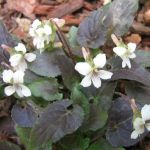| Common Name: |
Chinese Violet |
| Botanical Name: |
Viola yezoensis |
| Genus: |
Viola |
| Family: |
Violaceae |
| Location: |
Japan |
| Cultivation: |
Well-drained, moist, rich soil in sun or partial shade. Remove dead flowers promptly in order to prolong flowering. Plants may be damaged by slugs, snails, and viral and fungal diseases. Viola tricolor self sows freely. |
| Propagation: |
By seed sown when ripe or in spring; by stem tip cuttings in spring or late summer; by division in autumn or spring. |
| Harvest: |
Whole plants, leaves, and flowers are collected during the flowering season, and dried for use in decoctions (V. yezoensis), infusions, and liquid extracts. Roots are collected in autumn and dried for decoctions. Leaves of V. odorata are often used fresh, and flowers may also be picked in spring for extraction of essential oil. V. tricolor is often powdered when dried and used in skin creams. |
| Height: |
20cm (8in) |
| Width: |
20cm (8in) |
Hardiness: |
Z6-9 |
| Parts Used: |
Whole plant (zi hua di ding) |
| Properties: |
A bitter, pungent, cooling herb that clears toxins, reduces inflammation, and is anti-bacterial. |
| Medicinal Uses: |
Internally for boils, carbuncles, snakebite, skin disorders (especially erysipelas), mumps, and "hot" disorders with inflammtion of the eyes, throat, or ears. |
| Bibliography: |
Encylopedia of Herbs by Deni Brown Copyright ©: 1995, 2001 Dorling Kindersley Limited pg.405
|

